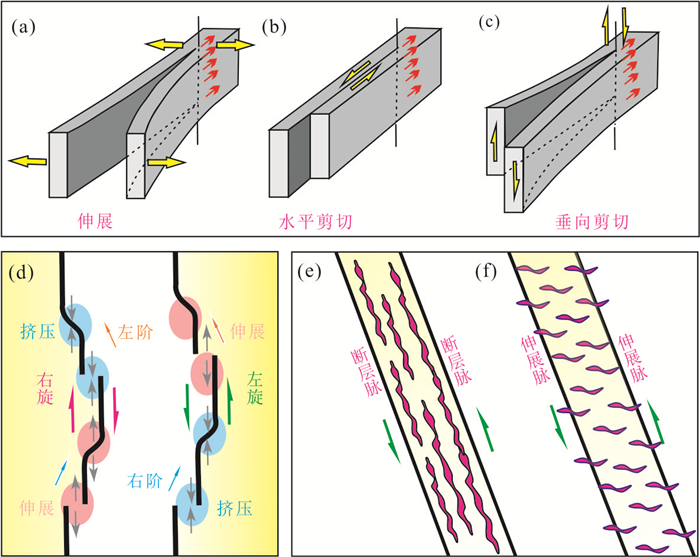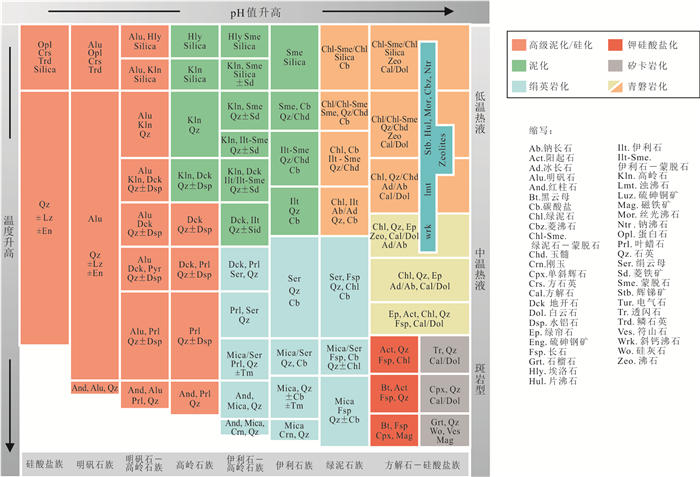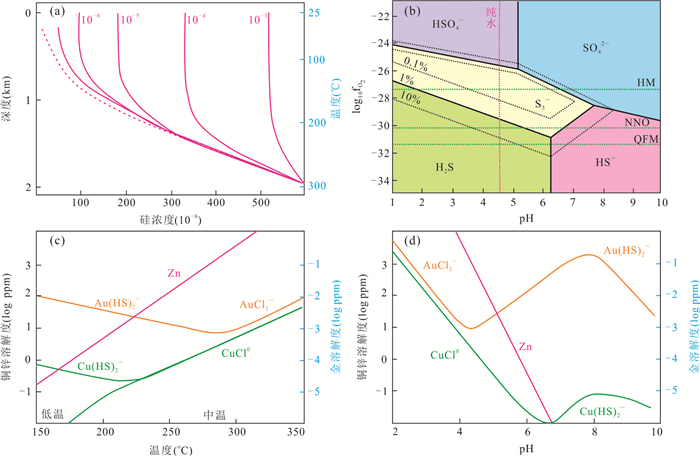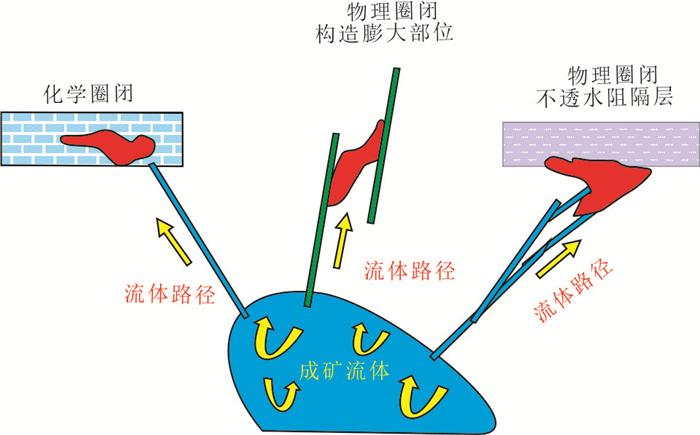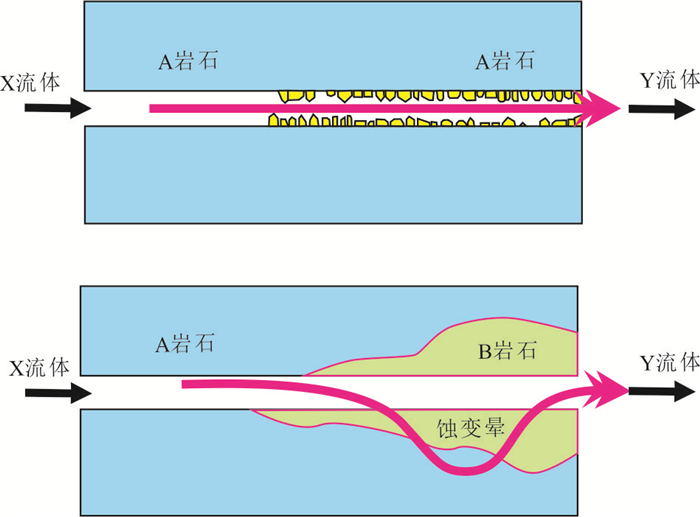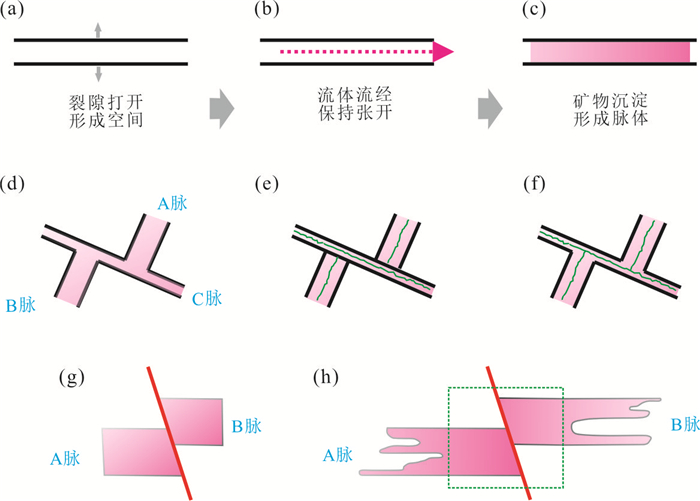Large-Scaled Structure-Alteration-Mineralization Mapping of the Hydrothermal Deposits: Basic Principle and Precautions
-
摘要: 热液矿床超大比例尺填图是指1∶1 000以及更大比例尺的填图,主要用来记录矿区内露头、平硐、钻孔和手标本上等肉眼可直接观察到的各类地质现象.热液矿床超大比例尺填图的目的是查明成矿作用的地质特征、空间分布和时间演化,对于准确判断热液矿床的成因类型和成矿过程,以及圈定矿体和布置勘探工程等实践活动具有重要意义.在实际工作中,初学者由于对热液矿床的复杂现象不知如何下手,对于“填什么”和“如何填”等问题不甚清楚.鉴于此,(1)从基本原理出发,重点阐述了热液矿床构造、流体、蚀变和矿化形成过程,提出“成矿流体+新鲜围岩→围岩蚀变+矿石”这一热液矿床形成的通用性公式,并提出“构造→骨骼”和“蚀变→血肉”的类比;(2)重点介绍了热液矿床超大比例尺填图过程中一些长期被忽略的问题,如,成矿环境判别、成矿流体通道与圈闭、热液充填与交代成矿作用以及脉体穿插与成矿期次判别等.同时,对这些地质现象背后隐藏的成因启示做了重点阐释.Abstract: Large-scale mapping of the hydrothermal deposits refers to the geological mapping with the scales of 1∶1 000 and the larger scales, which is mainly used to record various geological phenomena that can be directly observed with the naked eye, such as outcrops, flat tunnels, boreholes and hand specimens in the mining area. The purpose of large-scale mapping is to identify the metallogenic characteristics, spatial distribution and temporal evolution of the hydrothermal deposits, which are useful for accurately constraining the genetic type and metallogenic process of hydrothermal deposits, as well as assisting further prospecting and exploration. In the field survey, the beginners do not know how to describe and record the complex phenomena of the hydrothermal deposits, and they are also not very clear about what to fill and how to map. To address these issues, we try to weaken the genetic type of the ore deposit from the basic principle, focusing on the formation process of the structure, fluid, alteration and mineralization of the hydrothermal deposit, and propose "ore-forming fluid + fresh wall rock → wall rock alteration + ore" as a universal formula for the formation of hydrothermal deposits, and puts forward the analogies of "structure → skeleton" and "alteration → flesh". In addition, we focus on some long-ignored aspects in the process of large-scale mapping of hydrothermal deposits, such as identification of metallogenic environment, ore-forming fluid channels and traps, hydrothermal filling and metasomatism, and identification of vein cross-cutting, etc. Furthermore, we eventual focus is on explaining the hidden genetic inspiration behind these geological phenomena.
-
图 4 热液矿床常见的围岩蚀变组合及指示的成矿条件(据Corbett and Leach, 1998修改)
Fig. 4. Mineral assemblages and their forming condition of alteration in the hydrothermal deposits (modified after Corbett and Leach, 1998)
图 5 热液矿床主要矿物沉淀的控制因素
a.脉石矿物石英溶解度与深度和温度的相图(据Barnes,2015修改);b.不同pH和Eh条件下,热液中硫的稳定区间(据Barnes,2015修改);c.铜、金和锌的溶解度与温度的关系(据Corbett and Leach, 1998修改);d.铜、金和锌的溶解度与酸碱度的关系(据Corbett and Leach, 1998修改)
Fig. 5. Controls on mineral precipitation in the hydrothermal deposits
-
Barnes, H. L., 2015. Hydrothermal Processes. Geochemical Perspectives, 4(1): 1-93. https://doi.org/10.7185/geochempersp.4.1 Cao, R., Ma, X. H., Bagas, L., et al., 2021. Late Jurassic Intracontinental Extension and Related Mineralisation in Southwestern Fujian Province of SE China: Insights from Deformation and Syn-Tectonic Granites. Journal of Earth Science, 32(1): 158-173. https://doi.org/10.1007/s12583-020-1387-6 Chen, Y. J., Li, N., Deng, X. H., et al., 2020. Geology and Geochemistry of Molybdenum Deposits in the Qinling Orogen, P. R. China. Science Press, Beijing (in Chinese). Chen, J., Zhou, T. F., Zhang, L. J., et al., 2020. A Discussion of Characteristics, Genesis of Lithocaps and Their Distributions in South China. Acta Petrologica Sinica, 36(11): 3380-3396(in Chinese with English abstract). doi: 10.18654/1000-0569/2020.11.08 Chen, Y. J., Zhai, M. G., Jiang, S. Y., 2009. Significant Achievements and Open Issues in Study of Orogenesis and Metallogenesis Surrounding the North China Continent. Acta Petrologica Sinica, 25(11): 2695-2726(in Chinese with English abstract). Chen, Z. L., Chen, B. L., 2012. Thinking, Steps and Practice of Research on Ore-Field Structure in Geomechanics. Chinese Journal of Nature, 34(4): 208-215(in Chinese with English abstract). Chi, G. X., Xue, C. J., 2011. Principles, Methods and Applications of Hydrodynamic Studies of Mineralization. Earth Science Frontiers, 18(5): 1-18(in Chinese with English abstract). Corbett, G. J., Leach, T. M., 1998. Southwest Pacific Rim Gold-Copper Systems: Structure, Alteration, and Mineralization. Society of Economic Geologists, 6. https://doi.org/10.5382/SP.06 Deng, J., Yang, L. Q., Ge, L. S., et al., 2006. Research Progress on Structural System of Jiaodong Ore Concentration Area. Progress in Natural Science, 16(5): 513-518(in Chinese with English abstract). doi: 10.3321/j.issn:1002-008X.2006.05.001 Du, L. T., 2001. Basic Metallogenic Regularity and General Hydrothermal Metallogeny of Hydrothermal Uranium Deposits in China. Atomic Press, Beijing(in Chinese). Fan, H. R., Hu, F. F., Yang, J. H., et al., 2005. Fluid Evolution and Large-Scale Gold Metallogeny during Mesozoic Tectonic Transition in the Eastern Shandong Province. Acta Petrologica Sinica, 21(5): 1317-1328(in Chinese with English abstract). Fang, W. X., 2016. On Tectonic System of Hydrothermal Breccia: Objective, Methodology and Lithofacies-Mapping Applications. Geotectonica et Metallogenia, 40(2): 237-265(in Chinese with English abstract). Gu, X. X., Li, B. H., Zhang, Y. M., et al., 2019. Methodology and Applications of Metallogeny Research. China Geologic Press, Beijing (in Chinese). Hou, Z. Q., Yang, Z. M., 2009. Porphyry Deposits in Continental Settings of China: Geological Characteristics, Magmatic-Hydrothermal System, and Metallogenic Model. Acta Geologica Sinica, 83(12): 1779-1817(in Chinese with English abstract). doi: 10.3321/j.issn:0001-5717.2009.12.002 Hu, S. X., Ye, Y., Fang, C. Q., 2004. Petrology of Metasomatic Altered Rocks and Its Prospecting Significance. China Geologic Press, Beijing (in Chinese). Hu, H. L., Liu, S. L., Fan, H. R., et al., 2020. Structural Networks Constraints on Alteration and Mineralization Processes in the Jiaojia Gold Deposit, Jiaodong Peninsula, China. Journal of Earth Science, 31(3): 500-513. https://doi.org/10.1007/s12583-020-1276-z Hu, R. Z., Fu, S. L., Xiao, J. F., 2016. Major Scientific Problems on Low-Temperature Metallogenesis in South China. Acta Petrologica Sinica, 32(11): 3239-3251(in Chinese with English abstract). Li, H., Zhu, D. P., Shen, L. W., et al., 2022. A General Ore Formation Model for Metasediment-Hosted Sb-(Au-W) Mineralization of the Woxi and Banxi Deposits in South China. Chemical Geology. https://doi.org/10.1016/j.chemgeo.2022.121020 Li, J. W., Zhao, X. F., Deng, X. D., et al., 2019. An Overview of the Advance on the Study of China's Ore Deposits during the last Seventy Years. Scientia Sinica (Terrae), 49(11): 1720-1771(in Chinese with English abstract). Li, Z. K., Li, X. M., Jin, X. Y., et al., 2021. Age and Genesis of the Laodaizhanggou Pb-Zn-Ag Deposit in the Fudian Ore Field, Southern North China Craton: Implications for Regional Mineral Prospecting. Journal of Earth Science, 32(1): 195-207. https://doi.org/10.1007/s12583-020-1093-4 Liu, B., Wu, Q. H., Li, H., et al., 2021. Yanshanian NE-Striking Fault Evolution and Its Implications on Mineralization in the Xitian W-Sn Polymetallic Ore Field, Hunan Province. Earth Science, 46(1): 43-58(in Chinese with English abstract). Liu, Y. C., Hou, Z. Q., Yue, L. L., et al., 2022. Critical Metals in Sediment-Hosted Pb-Zn Deposits in China. Chinese Science Bulletin, 67(4): 406-424(in Chinese with English abstract). Lu, H. Z., Fan, H. R., Ni, P., et al., 2004. Fluid Inclusion. Science Press, Beijing (in Chinese). Mao, J. W., Wu, S. H., Song, S. W., et al., 2020. The World-Class Jiangnan Tungsten Belt: Geological Characteristics, Metallogeny, and Ore Deposit Model. Chinese Science Bulletin, 65(33): 3746-3762(in Chinese with English abstract). doi: 10.1360/TB-2020-0370 Ni, P., Chi, Z., Pan, J. Y., 2020. An Integrated Investigation of Ore-Forming Fluid Evolution in Porphyry and Epithermal Deposits and Their Implication on Exploration. Earth Science Frontiers, 27(2): 60-78(in Chinese with English abstract). Pirajno, F., 2009. Hydrothermal Processes and Mineral System. Springer, Netherlands. https://doi.org/10.1007/978-1-4020-8613-7 Qin, K. Z., Zhai, M. G., Li, G. M., et al., 2017. Links of Collage Orogenesis of Multiblocks and Crust Evolution to Characteristic Metallogeneses in China. Acta Petrologica Sinica, 33(2): 305-325(in Chinese with English abstract). Song, S. M., Wen, G. J., Shen, W. J., et al., 2021. Specification for Geological Mapping of Solid Mineral Exploration. China Geologic Press, Beijing (in Chinese). Song, M. C., Ding, Z. J., Liu, X. D., et al., 2022. Structural Controls on the Jiaodong Type Gold Deposits and Metallogenic Model. Acta Geologica Sinica, 96(5): 1774-1802(in Chinese with English abstract). doi: 10.3969/j.issn.0001-5717.2022.05.017 Sun, W. D., Ling, M. X., Yang, X. Y., et al., 2010. Ridge Subduction and Porphyry Copper-Gold Mineralization. Scientia Sinica (Terrae), 40(2): 127-137(in Chinese with English abstract). doi: 10.1360/zd2010-40-2-127 Tang, J. X., Song, Y., Wang, Q., et al., 2016. Geological Characteristics and Exploration Model of the Tiegelongnan Cu(Au-Ag) Deposit: The First Ten Million Tons Metal Resources of a Porphyry-Epithermal Deposit in Tibet. Acta Geoscientica Sinica, 37(6): 663-690(in Chinese with English abstract). Taylor, R. D., Leach, D. L., Bradley, D. C., 2009. Compilation of Mineral Resource Data for Mississippi Valley-Type and Clastic-Dominated Sediment-Hosted Lead-Zinc Deposits. U. S. Geological Survey Open-file Report 2009-1297. Wang, G. W., Zhang, Z. Q., Li, R. X., et al., 2021. Resource Prediction and Assessment Based on 3D/4D Big Data Modeling and Deep Integration in Key Ore Districts of North China. Scientia Sinica (Terrae), 51(9): 1594-1610(in Chinese with English abstract). doi: 10.1360/SSTe-2020-0289 Wang, T., Ji, W. H., Hu, J. M., et al., 2016. Geological Mapping for Special Issues and a Discussion on Related Topics. Geological Bulletin of China, 35(5): 633-641(in Chinese with English abstract). doi: 10.3969/j.issn.1671-2552.2016.05.001 Yang, Z. M., Hou, Z. Q., Song, Y. C., et al., 2008. Qulong Superlarge Porphyry Cu Deposit in Tibet: Geology, Alteration and Mineralization. Mineral Deposits, 27(3): 279-318(in Chinese with English abstract). doi: 10.3969/j.issn.0258-7106.2008.03.002 Yang, Z. M., Hou, Z. Q., Yang, Z. S., et al., 2012. Application of Short Wavelength Infrared(SWIR) Technique in Exploration of Poorly Eroded Porphyry Cu District: A Case Study of Niancun Ore District, Tibet. Mineral Deposits, 31(4): 699-717(in Chinese with English abstract). doi: 10.3969/j.issn.0258-7106.2012.04.004 Ye, T. Z., Lv, Z. C., Pang, Z. S., et al., 2014. Theory and Methodology of Prospecting Prediction in Exploration Area. China Geologic Press, Beijing (in Chinese). Yuan, Y. M., Zhao, W. X., Zhang, Z. J., et al., 2008. Teaching System and Content of Geological Field Practice in Zhou Koudian. Chinese Geological Education, 17(2): 61-66(in Chinese with English abstract). doi: 10.3969/j.issn.1006-9372.2008.02.018 Zhai, Y. S., Peng, R. M., Xiang, Y. C., et al., 2004. Methodology of Reginal Metallogenic Research. China Land Press, Beijing (in Chinese). Zhai, Y. S., Yao, S. Z., Cai, K. Q., 2011. Metalogeny (Third Edition). China Geologic Press, Beijing (in Chinese). Zhai, M. G., 2010. Tectonic Evolution and Metallogenesis of North China Craton. Mineral Deposits, 29(1): 24-36(in Chinese with English abstract). doi: 10.3969/j.issn.0258-7106.2010.01.004 Zhang, C. Q., Rui, Z. Y., Chen, Y. C., et al., 2013. The Main Successive Strategic Bases of Resources for Pb-Zn Deposits in China. Geology in China, 40(1): 248-272(in Chinese with English abstract). doi: 10.3969/j.issn.1000-3657.2013.01.017 Zheng, Y., Zhang, G. Z., Wu, Y. H., 2022. Triassic Multistage Antimony-Gold Mineralization in the Precambrian Sedimentary Rocks of South China: Insights from Structural Analysis, Paragenesis, 40Ar/39Ar Age, In-Situ S-Pb Isotope and Trace Elements of the Longwangjiang-Jiangdongwan Orefield, Xuefengshan Mountain. Ore Geology Reviews. https://doi.org/10.1016/j.oregeorev.2022.105030 Zhou, J. X., Luo, K., Sun, G. T., 2021. Se Extremely Enriched in the Dingtoushan Pb-Zn Deposit, Qinglong City, Guizhou Province, China. Geology in China, 48(1): 339-340(in Chinese with English abstract). Zhou, T. F., Fan, Y., Wang, S. W., et al., 2017. Metallogenic Regularity and Metallogenic Model of the Middle-Lower Yangtze River Valley Metallogenic Belt. Acta Petrologica Sinica, 33(11): 3353-3372(in Chinese with English abstract). 陈静, 周涛发, 张乐骏, 等, 2020. 蚀变岩帽的特征、成因以及在华南的分布探讨. 岩石学报, 36(11): 3380-3396. doi: 10.18654/1000-0569/2020.11.08 陈衍景, 翟明国, 蒋少涌, 2009. 华北大陆边缘造山过程与成矿研究的重要进展和问题. 岩石学报, 25(11): 2695-2726. https://www.cnki.com.cn/Article/CJFDTOTAL-YSXB200911003.htm 陈衍景, 李诺, 邓小华, 等, 2020. 秦岭造山带钼矿床成矿规律. 北京: 科学出版社. 陈正乐, 陈柏林, 2012. 地质力学矿田构造研究思路、步骤与实践. 自然杂志, 34(4): 208-215. https://www.cnki.com.cn/Article/CJFDTOTAL-ZRZZ201204005.htm 池国祥, 薛春纪, 2011. 成矿流体动力学的原理、研究方法及应用. 地学前缘, 18(5): 1-18. https://www.cnki.com.cn/Article/CJFDTOTAL-DXQY201105001.htm 邓军, 杨立强, 葛良胜, 等, 2006. 胶东矿集区形成的构造体制研究进展. 自然科学进展, 16(5): 513-518. doi: 10.3321/j.issn:1002-008X.2006.05.001 翟明国, 2010. 华北克拉通的形成演化与成矿作用. 矿床地质, 29(1): 24-36. doi: 10.3969/j.issn.0258-7106.2010.01.004 翟裕生, 彭润民, 向运川, 等, 2004. 区域成矿研究法. 北京: 中国大地出版社. 翟裕生, 姚书振, 蔡克勤, 2011. 矿床学(第三版). 北京: 地质出版社. 杜乐天, 2001. 中国热液铀矿基本成矿规律和一般热液成矿学. 北京: 原子能出版社. 范宏瑞, 胡芳芳, 杨进辉, 等, 2005. 胶东中生代构造体制转折过程中流体演化和金的大规模成矿. 岩石学报, 21(5): 1317-1328. https://www.cnki.com.cn/Article/CJFDTOTAL-YSXB200505000.htm 方维萱, 2016. 论热液角砾岩构造系统及研究内容、研究方法和岩相学填图应用. 大地构造与成矿学, 40(2): 237-265. https://www.cnki.com.cn/Article/CJFDTOTAL-DGYK201602006.htm 顾雪祥, 李葆华, 章永梅, 等, 2019. 矿床学研究方法与应用. 北京: 地质出版社. 侯增谦, 杨志明, 2009. 中国大陆环境斑岩型矿床: 基本地质特征、岩浆热液系统和成矿概念模型. 地质学报, 83(12): 1779-1817. https://www.cnki.com.cn/Article/CJFDTOTAL-DZXE200912002.htm 胡瑞忠, 付山岭, 肖加飞, 2016. 华南大规模低温成矿的主要科学问题. 岩石学报, 32(11): 3239-3251. https://www.cnki.com.cn/Article/CJFDTOTAL-YSXB201611001.htm 胡受奚, 叶瑛, 方长泉, 2004. 交代蚀变岩岩石学及其找矿意义. 北京: 地质出版社. 李建威, 赵新福, 邓晓东, 等, 2019. 新中国成立以来中国矿床学研究若干重要进展. 中国科学: 地球科学, 49(11): 1720-1771. https://www.cnki.com.cn/Article/CJFDTOTAL-JDXK201911003.htm 刘飚, 吴堑虹, 李欢, 等, 2021. 湖南锡田钨锡多金属矿田燕山期NE向断层演化历史及其成矿意义. 地球科学, 46(1): 43-58. doi: 10.3799/dqkx.2019.263 刘英超, 侯增谦, 岳龙龙, 等, 2022. 中国沉积岩容矿铅锌矿床中的关键金属. 科学通报, 67(4): 406-424. https://www.cnki.com.cn/Article/CJFDTOTAL-KXTB2022Z1008.htm 卢焕章, 范宏瑞, 倪培, 等, 2004. 流体包裹体. 北京: 科学出版社. 毛景文, 吴胜华, 宋世伟, 等, 2020. 江南世界级钨矿带: 地质特征、成矿规律和矿床模型. 科学通报, 65(33): 3746-3762. https://www.cnki.com.cn/Article/CJFDTOTAL-KXTB202033010.htm 倪培, 迟哲, 潘君屹, 2020. 斑岩型和浅成低温热液型矿床成矿流体与找矿预测研究: 以华南若干典型矿床为例. 地学前缘, 27(2): 60-78. https://www.cnki.com.cn/Article/CJFDTOTAL-DXQY202002006.htm 秦克章, 翟明国, 李光明, 等, 2017. 中国陆壳演化、多块体拼合造山与特色成矿的关系. 岩石学报, 33(2): 305-325. https://www.cnki.com.cn/Article/CJFDTOTAL-YSXB201702001.htm 宋明春, 丁正江, 刘向东, 等, 2022. 胶东型金矿床断裂控矿及成矿模式. 地质学报, 96(5): 1774-1802. https://www.cnki.com.cn/Article/CJFDTOTAL-DZXE202205017.htm 宋明春, 温桂军, 申文金, 2021. 中华人民共和国地质矿产行业标准固体矿产勘查地质填图规范DZ/T0382-2021. 北京: 地质出版社. 孙卫东, 凌明星, 杨晓勇, 等, 2010. 洋脊俯冲与斑岩铜金矿成矿. 中国科学: 地球科学, 40(2): 127-137. https://www.cnki.com.cn/Article/CJFDTOTAL-JDXK201002001.htm 唐菊兴, 宋扬, 王勤, 等, 2016. 西藏铁格隆南铜(金银)矿床地质特征及勘查模型: 西藏首例千万吨级斑岩-浅成低温热液型矿床. 地球学报, 37(6): 663-690. https://www.cnki.com.cn/Article/CJFDTOTAL-DQXB201606003.htm 王功文, 张智强, 李瑞喜, 等, 2021. 华北重点矿集区大数据三维/四维建模与深层次集成的资源预测评价. 中国科学: 地球科学, 51(9): 1594-1610. https://www.cnki.com.cn/Article/CJFDTOTAL-JDXK202109011.htm 王涛, 计文化, 胡建民, 等, 2016. 专题地质填图及有关问题讨论. 地质通报, 35(5): 633-641. https://www.cnki.com.cn/Article/CJFDTOTAL-ZQYD201605001.htm 杨志明, 侯增谦, 宋玉财, 等, 2008. 西藏驱龙超大型斑岩铜矿床: 地质、蚀变与成矿. 矿床地质, 27(3): 279-318. https://www.cnki.com.cn/Article/CJFDTOTAL-KCDZ200803003.htm 杨志明, 侯增谦, 杨竹森, 等, 2012. 短波红外光谱技术在浅剥蚀斑岩铜矿区勘查中的应用: 以西藏念村矿区为例. 矿床地质, 31(4): 699-717. https://www.cnki.com.cn/Article/CJFDTOTAL-KCDZ201204005.htm 叶天竺, 吕志成, 庞振山, 等, 2014. 勘查区找矿预测理论与方法(总)论. 北京: 地质出版社. 袁晏明, 赵温霞, 章泽军, 等, 2008. 周口店野外地质实践教学体系与内容. 中国地质教育, 17(2): 61-66. https://www.cnki.com.cn/Article/CJFDTOTAL-JYDZ200802022.htm 张长青, 芮宗瑶, 陈毓川, 等, 2013. 中国铅锌矿资源潜力和主要战略接续区. 中国地质, 40(1): 248-272. https://www.cnki.com.cn/Article/CJFDTOTAL-DIZI201301019.htm 周家喜, 罗开, 孙国涛, 2021. 贵州晴隆丁头山铅锌矿床发现硒超常富集. 中国地质, 48(1): 339-340. https://www.cnki.com.cn/Article/CJFDTOTAL-DIZI202101027.htm 周涛发, 范裕, 王世伟, 等, 2017. 长江中下游成矿带成矿规律和成矿模式. 岩石学报, 33(11): 3353-3372. https://www.cnki.com.cn/Article/CJFDTOTAL-YSXB201711002.htm -










 下载:
下载:

